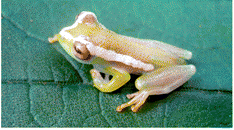Hyperolius spinigularis facts for kids
Quick facts for kids Hyperolius spinigularis |
|
|---|---|
 |
|
| Conservation status | |
| Scientific classification |
The Hyperolius spinigularis is a type of frog that belongs to the Hyperoliidae family. People often call it the spiny-throated reed frog or Mulanje reed frog. You can find this special frog in the Mulanje Massif mountains in southern Malawi. It also lives in the Namuli Massif in nearby Mozambique.
Male Hyperolius spinigularis frogs have tiny spines on their throats. These spines appear during the time they look for a mate.
Contents
About the Spiny Reed Frog
Scientists first described the Hyperolius spinigularis in 1971. They found the first frogs in Malawi. At first, they thought this frog lived in Tanzania too.
Later, new studies showed that the frogs in Tanzania were actually different species. So, the Hyperolius spinigularis is now known to live only in Malawi and Mozambique. The frogs once confused with it are now called Hyperolius burgessi, Hyperolius davenporti, and Hyperolius ukwiva. This shows how scientists learn more over time!
What Does the Spiny Reed Frog Look Like?
Male Hyperolius spinigularis frogs are about 19 to 23 millimeters long. That's about the length of a small paperclip! Females are a bit bigger, measuring 24 to 31 millimeters.
Males have special black spines during the breeding season. These spines cover their throat, chin, belly, and the underside of their back legs. Their head is wide, and their eyes stick out. The pupil of their eye is shaped like a horizontal oval.
Most of these frogs are a pale apple-green color. They have tiny brown spots on their backs. These spots can sometimes make their green color look darker. Their belly is a light see-through blue-green. It becomes silvery-white on their main body. Their hands and feet are pale yellow.
Some males are different. They can be red-brown on their back and belly. Their legs might be pale red. The white patterns on their backs also vary. Some have a white band from their nose to their back. Others have a broken band or a triangle shape on their forehead.
When these frogs are very young, just after changing from tadpoles, they are about 12.7 to 14.1 millimeters long.
Life and Habits of the Spiny Reed Frog
The Hyperolius spinigularis has a short breeding season. It happens from late December to mid-March. This is during the last of the rainy season.
Male frogs arrive at the breeding spots before the females. Scientists have not heard these frogs make sounds in their natural home. However, frogs kept in labs sometimes make calls.
Females lay their eggs on leaves. They place the eggs above the water. One time, a female frog was seen returning to her eggs. She sprayed a watery fluid over the eggs from her body.
These frogs can also go into a special sleep called Hibernation. This has been seen in frogs kept in labs. Before they hibernate, they stop wanting to eat. They become less active. Then, they hide among grass roots near the water. They often position themselves with their head up. Their back parts might touch the water or even be partly underwater.
Scientists have not seen this behavior in the wild. But the timing in lab frogs matches when wild frogs disappear from their breeding spots.
Where the Spiny Reed Frog Lives and How We Protect It
The Hyperolius spinigularis lives in forests. It also lives in grassy wetlands called dambo habitats. You can find them at heights from 690 to 1250 meters above sea level. They breed in pools that appear during the rainy season and in pools that stay year-round.
This frog is quite common in Malawi. We don't know how many there are in Mozambique. Sadly, their homes are shrinking. Forests are being cut down. Land is being cleared for farming. Sometimes, fire is used to clear land, which also harms their habitat.
Because of these threats, the International Union for Conservation of Nature (IUCN) has listed this frog as "Vulnerable". This means it could become endangered if we don't protect it.


